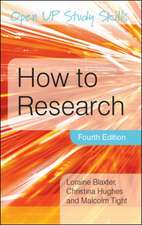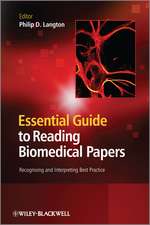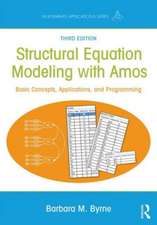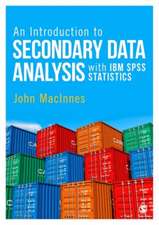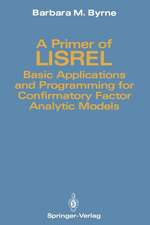Structural Equation Modeling with EQS and EQS/WINDOWS: Basic Concepts, Applications, and Programming
Autor Barbara Byrneen Limba Engleză Paperback – 18 apr 1994
| Toate formatele și edițiile | Preț | Express |
|---|---|---|
| Paperback (1) | 722.58 lei 6-8 săpt. | |
| SAGE Publications – 18 apr 1994 | 722.58 lei 6-8 săpt. | |
| Hardback (1) | 1001.32 lei 6-8 săpt. | |
| SAGE Publications – 18 apr 1994 | 1001.32 lei 6-8 săpt. |
Preț: 722.58 lei
Preț vechi: 881.19 lei
-18% Nou
Puncte Express: 1084
Preț estimativ în valută:
138.26€ • 144.08$ • 114.48£
138.26€ • 144.08$ • 114.48£
Carte tipărită la comandă
Livrare economică 03-17 aprilie
Preluare comenzi: 021 569.72.76
Specificații
ISBN-13: 9780803950924
ISBN-10: 0803950926
Pagini: 304
Ilustrații: 1
Dimensiuni: 152 x 229 x 20 mm
Greutate: 0.45 kg
Ediția:1
Editura: SAGE Publications
Colecția Sage Publications, Inc
Locul publicării:Thousand Oaks, United States
ISBN-10: 0803950926
Pagini: 304
Ilustrații: 1
Dimensiuni: 152 x 229 x 20 mm
Greutate: 0.45 kg
Ediția:1
Editura: SAGE Publications
Colecția Sage Publications, Inc
Locul publicării:Thousand Oaks, United States
Recenzii
"Byrne’s book is a delightfully written, systematic approach to the practical use of structural equation modeling in research. It begins with first principles and advances systematically through intermediate and advanced topics, introducing at each step the theory that is relevant as well as the practical models needed to implement these ideas on real models used in actual research contexts. The reader can then easily modify the examples for their own research since the types of models discussed will be relevant in many research contexts. The book is also timely, being the first text to show how statistics generally, and modeling in particular, can be fun in the Windows environment."
". . . . Newcomers to SEM who want to use EQS or EQS/Windows would benefit greatly from this book, either for self-teaching or as a supplemental guide in a course. . . . Byrne intends her books ‘to provide a practical guide to SEM using the EQS approach.’ She succeeds admirably."
". . . . Newcomers to SEM who want to use EQS or EQS/Windows would benefit greatly from this book, either for self-teaching or as a supplemental guide in a course. . . . Byrne intends her books ‘to provide a practical guide to SEM using the EQS approach.’ She succeeds admirably."
Cuprins
Foreword - Peter M Bentler
PART ONE: INTRODUCTION
Structural Equation Models
Using the EQS Program
PART TWO: SINGLE-GROUP ANALYSES
Application 1
Testing the Factorial Validity of a Theoretical Construct (1st-order CFA Model)
Application 2
Testing the Factorial Validity of a Measuring Instrument (1st-order CFA Model)
Application 3
Testing the Factorial Validity of a Measuring Instrument (2nd-order CFA Model)
Application 4
Testing for Construct Validity Via the Multitrait-Multimethod Model
Application 5
Testing the Validity of a Causal Structure
PART THREE: MULTIPLE GROUP ANALYSES
Application 6
Testing for Invariant Factorial Structure of a Theoretical Construct (1st-order CFA Model)
Application 7
Testing for Invariant Factorial Structure of a Measuring Instrument (1st-order CFA Model)
Application 8
Testing for Invariant Latent Mean Structures
Application 9
Testing for Invariant Causal Structure
PART FOUR: WINDOW TREATMENTS: A LOOK AT EQS/WINDOWS (VERSION 4)
Introduction to EQS/Windows
Application 10
Preliminary Data-Screening Analyses
Application 11
Building an EQS Model File - Instantly!
PART ONE: INTRODUCTION
Structural Equation Models
Using the EQS Program
PART TWO: SINGLE-GROUP ANALYSES
Application 1
Testing the Factorial Validity of a Theoretical Construct (1st-order CFA Model)
Application 2
Testing the Factorial Validity of a Measuring Instrument (1st-order CFA Model)
Application 3
Testing the Factorial Validity of a Measuring Instrument (2nd-order CFA Model)
Application 4
Testing for Construct Validity Via the Multitrait-Multimethod Model
Application 5
Testing the Validity of a Causal Structure
PART THREE: MULTIPLE GROUP ANALYSES
Application 6
Testing for Invariant Factorial Structure of a Theoretical Construct (1st-order CFA Model)
Application 7
Testing for Invariant Factorial Structure of a Measuring Instrument (1st-order CFA Model)
Application 8
Testing for Invariant Latent Mean Structures
Application 9
Testing for Invariant Causal Structure
PART FOUR: WINDOW TREATMENTS: A LOOK AT EQS/WINDOWS (VERSION 4)
Introduction to EQS/Windows
Application 10
Preliminary Data-Screening Analyses
Application 11
Building an EQS Model File - Instantly!
Descriere
Designed to help beginners estimate and test structural equation modeling (SEM) using the EQS approach, this book demonstrates a variety of SEM//EQS applications that include both partial factor analytic and full latent variable models. Beginning with an overview of the basic concepts of SEM and the EQS program, the author works through applications starting with a single sample approach to more advanced applications, such as a multi-sample approach. The book concludes with a section on using EQS for modeling with Windows.

